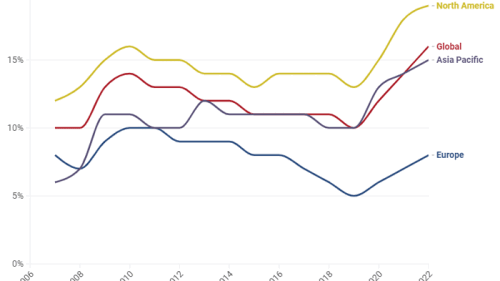The summer of 2015 saw the most significant legal and regulatory developments to break down residential segregation since the days immediately after the assassination of Dr. Martin Luther King Jr. on April 4, 1968—with potentially profound impacts for communities across the United States. At the heart of separate but related actions by the U.S. Supreme Court and the U.S. Department of Housing and Urban Development (HUD) is the Fair Housing Act (FHA), enacted one week after King’s death as the capstone of the civil rights political and legislative campaigns of the 1960s.
The FHA banned racial and other discrimination in the sale or rental of housing and prohibited egregious tactics widely used in the real estate industry at the time that had the same effect, such as “block busting” and racial steering. The FHA also required state and local agencies that receive federal housing funds to “affirmatively further” fair housing, by assessing barriers and acting to overcome them in their jurisdictions.
Nearly 50 years later, overt and covert forms of discrimination persist in the housing market; and while residential segregation has dropped substantially, it remains high in many larger metropolitan areas. Part of the reason for this has been the poorly defined and unenforced “affirmatively furthering” requirement. With research increasingly showing that children have better educational and economic outcomes when they move from high-poverty to low-poverty areas, the FHA’s failure to achieve its full purpose is magnified.
Two Changes for Fair Housing
The Disparate Impact Decision
In the Supreme Court case (Texas Department of Housing and Community Affairs v. the Inclusive Communities Project Inc.), the Court affirmed that the FHA applies to acts of discrimination in housing, even if they are unintentional, under the principle of “disparate impact.” This decision will affect developers, property owners, financial institutions, and others involved in either selling or renting housing. Note that a disparate impact finding requires that the housing practice has been proven to have a disproportionately adverse effect on a protected class; research shows that the connection is causal; the barrier to equal outcomes is “artificial, arbitrary, and unnecessary”; and the action does not fulfill a legitimate business purpose. In response to the Court’s opinion, HUD Secretary Julián Castro said, “The Supreme Court has made it clear that HUD can continue to use this critical tool to eliminate the unfair barriers that have deferred and derailed too many dreams.”
The ruling has closed some loopholes that perpetuate racial segregation, in keeping with the apparent intent of the Fair Housing Act. Just as the act prohibited common practices at the time, such as “block busting,” in which real estate workers would persuade white families to sell quickly out of fear of racial change in the area, the disparate impact decision may be interpreted to prohibit common causes of racial segregation today and in the future. The test of illegality is primarily whether statistical data indicate that an action causes a disproportionately adverse effect on minorities or another protected group.
The Court’s majority opinion clearly states that the decision does not prohibit targeted revitalization of neighborhoods, which presumably would not be classified as arbitrary or falls within one of the other exceptions.
The Affirmatively Furthering Fair Housing Rule
The Affirmatively Furthering Fair Housing rule pertains to HUD grantees, a smaller but vital portion of the land use community. The rule provides much-needed guidance on the Fair Housing Act provision, which “requires jurisdictions to take actions that can undo historic patterns of segregation and other types of discrimination, as well as to take actions to promote fair housing choice and foster inclusive communities.” The rule, which will be accompanied by a data tool, mandates HUD grantees to use their funds to address current patterns of segregation and inequality.
HUD grantees, which include states, housing authorities, and other jurisdictions or agencies, will be required to analyze and report on indicators and causes of residential segregation, racially or ethnically concentrated areas of poverty, significant disparities in access to opportunity, and disproportionate housing needs. They will also be required to develop and report to HUD on their strategies and actions for addressing those issues with federal funds. Jurisdictions that fail to comply may lose federal funds.
Potential Impacts for Planning and Development
The Supreme Court opinion and HUD regulation each elicited strong responses from proponents and detractors. Housing experts and legal analysts are still weighing their potential impacts, with most agreeing that they will be wide ranging and will evolve over time. While the HUD regulation does not take full effect for most jurisdictions until 2020 at the earliest, states and cities are expected to start planning and accounting for them much sooner.
Among the potential impacts that can be forecast at present are the following:
A volatile political environment at the local level. While many conservative elected officials and commentators have harshly condemned the actions, the fact that some of the most segregated communities in the country are in largely liberal metropolitan areas suggests that the local political dynamics could play out in unexpected ways. As the political scientist Thomas Edsall observed: “The Supreme Court and HUD have together set in motion a major test of middle- and upper-middle-class white America, which will determine whether support for racial equality goes beyond calls to lower the Confederate flag, beyond demands for stricter oversight of the police in minority neighborhoods, and on to a willingness to tolerate racial change in the house next door.”
A higher standard for community development. The federal government and other supporters of the Supreme Court’s and HUD’s actions are clear that their principal purpose, and benefit, is to enhance efforts to enable more minorities to live in less segregated, more opportunity-rich neighborhoods. While both the Court and HUD indicated that investments in more segregated, distressed communities may be appropriate and necessary, it is highly likely that developers and advocates of traditional community development will need to meet much higher standards for showing how current and future minority residents would benefit from revitalization. Community developers may face more concerted legal opposition to their housing activities as well.
A greater need for metropolitan housing approaches. In some of the nation’s most segregated areas, zoning, land use, and development decisions that reflect the aims of the Court opinion and HUD regulation will cross city and county lines. Only a few parts of the country have implemented regional housing strategies with federal funds, but initially encouraging results in some suggest opportunities for others. The Chicago Regional Housing Choice Initiative and the Metropolitan Council (serving Minneapolis and St. Paul) are two examples of entities coordinating the use of rental housing vouchers on a regional basis. Regionally focused funds for affordable housing development and preservation are operating in Denver, the San Francisco Bay area, and Seattle. California and New Jersey have developed regional “fair share” housing plans.
Increasing the Value of Evidence
The changes by both the Court and HUD direct the development community to let evidence guide the way in breaking down segregation. Extensive research documents the connection between certain types of housing policies and programs and disparate impacts by race or ethnicity. But not all connections are causal. To stay on the right side of the disparate impact decision and to be effective in using HUD funds to remedy segregation, developers, planners, policy makers, and advocates need to know whether a practice is shown to cause differential outcomes and opportunities.
For example, research by Jonathan Rothwell and Douglas Massey, published in Urban Affairs Review, found that metropolitan areas with greater allowable density have less racial segregation. Their analysis further shows that the connection is causal: antidensity zoning increases racial segregation. This evidence, along with other research findings, may lead to quite heated legal battles over whether density restrictions are arbitrary and unnecessary.
Massey’s subsequent research in Mount Laurel, New Jersey, published in Climbing Mount Laurel, shows that the fears of increased density did not pan out. Mount Laurel is a bucolic town in the Philadelphia suburbs with single-family homes on large lots and sprawling town parks with ample parking and recreational opportunities. It was also the site of a landmark lawsuit over the use of antidensity zoning to bar the development of clustered townhouses in the community. The town remains largely an affluent single-family-home community, yet the housing stock now includes multifamily developments, some of which are designated as affordable. Massey examined the impact of an affordable development in Mount Laurel, the Ethel Lawrence Homes. There has been no spike in crime rates, no reduction in property values, and no increase in tax burdens in the surrounding area.
Evidence about what causes segregation and whether the remedies lead to spillover harms is essential as the field strives to navigate a new fair housing landscape. However, Mount Laurel also provides a lesson in how long it can take for a court decision to lead to change. While the New Jersey Supreme Court decided the case in 1975 and affirmed it in 1983, the development in question, the Ethel Lawrence Homes, was only opened in 2000.
The loopholes are closing, but change will not happen overnight. Exclusion by race, ethnicity, gender, age, disability, family status, and other protected classes is no longer permitted. But will it take 25 years of legal battles and delays before the door to opportunity is open in reality? Perhaps. In the meantime, all of the land use community should not just wait and see how the changes play out. Instead, we should fight to remedy residential segregation through our daily work—increasing the housing supply, building homes targeted to the local workforce, and strengthening communities where homes are already affordable.
All families should be able to live in a modest home in a neighborhood that meets their needs. The need is great. Let’s bring down the barriers that are restricting supply.




